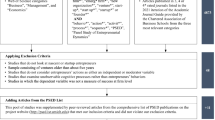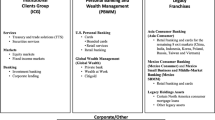Abstract
The capacity to innovate impacts organizational performance and is crucial for competitive advantage. However, as structural inertia sets in, large organizations tend to lose their ability to sustain continuous knowledge creation dynamics. Moreover, created knowledge is not always efficiently integrated into new marketable product offerings. As a consequence, organizations continually experiment with designs allowing them to combine both imperatives. Drawing on a longitudinal case study of a large firm operating in the highly competitive Specialty Chemicals industry, we explore how this organization has been able to conjugate the apparently contradictory processes of knowledge creation and integration. Our findings suggest that this capacity is enhanced by effective knowledge flows within and between the different organizational communities.
Similar content being viewed by others
References
Amin A and Roberts J (2008) Knowing in action: beyond communities of practice. Research Policy 37 (2), 353–369.
Blanchet A and Gotman A (1992) L’Enquête et ses Méthodes: L’Entretien. Nathan, Paris.
Borzillo S and Kaminska-Labbé R (2011) Unravelling the dynamics of knowledge creation in communities of practice though complexity theory lenses. Knowledge Management Research & Practice 9 (4), 353–366.
Brown JS and Duguid P (1991) Organizational learning and communities of practice: toward a unified view of working, learning, and innovation. Organization Science 2 (1), 40–57.
Brown JS and Duguid P (1998) Organizing knowledge. California Management Review 40 (3), 90–111.
Brown SL and Eisenhardt KM (1997) The art of continuous change: linking complexity theory and time-paced evolution in relentlessly shifting organizations. Administrative Science Quarterly 42 (1), 1–34.
Burgelman RA (1991) Intraorganizational ecology of strategy making and organizational adaptation: theory and field research. Organization Science 2 (3), 239–262.
Burgelman RA (2002) Strategy as vector and the inertia of coevolutionary lock-in. Administrative Science Quarterly 47 (2), 325–357.
Coakes E and Smith P (2007) Developing communities of innovation by identifying innovation champions. The International Journal of Knowledge and Organizational Learning Management 14 (1), 74–85.
Cohendet P and Diani M (2003) L’organisation comme une communauté de communautés: croyances collectives et culture d’entreprise. REP 113 (5), 697–720.
Cohendet P and Llerena P (2003) Routines and incentives: the role of communities in the firm. Industrial and Corporate Change 12 (2), 271–297.
Cox A (2005) What are communities of practice? A comparative review of four seminal works. Journal of Information Science 31 (6), 527–540.
Cummings JN (2004) Work groups, structural diversity, and knowledge sharing in a global organization. Management Science 50 (3), 352–364.
Dannecker A and Lechner U (2007) Knowledge creation in virtual communities of patients: the role of quality assurance, Proc 13th Americas Conference on Information Systems, Keystone, Colorado, USA.
D’Aveni RA (1994) Hypercompetition: Managing the Dynamics of Strategic Manouvering. Free Press, New York.
Daft RL and Weick KE (1984) Toward a model of organizations as interpretation systems. Academy of Management Review 9 (2), 284–295.
Dougherty D (2008) Bridging social constraint and social action to design organizations for innovation. Organization Studies 29 (03), 415–434.
Dubé L, Bourhis A and Jacob R (2005) The impact of structuring characteristics on the launching of virtual communities of practice. Journal of Organizational Change Management 18 (2), 145–166.
Dubé L, Bourhis A and Jacob R (2006) Towards a typology of virtual communities of practice. Interdisciplinary Journal of Information, Knowledge, and Management 1, 69–93.
Duncan R (1976) The ambidextrous organization: designing dual structures for innovation. In The Management of Organization (Killman RH, Pondy LR and Sleven D, Eds), pp 167–188, North Holland, New York.
Eisenhardt KM (1989) Building theories from case study research. Academy of Management Review 14 (4), 532–550.
Eisenhardt KM and Martin JA (2000) Dynamic capabilities: what are they? Strategic Management Journal 21 (10–11), 1105–1121.
Franke N and Shah S (2003) How communities support innovative activities: an exploration of assistance and sharing among end-users. Research Policy 32 (1), 157–178.
Galunic DC and Eisenhardt KM (2001) Architectural innovation and modular corporate forms. Academy of Management Journal 44 (6), 1229–1249.
Gebert D, Boerner S and Kearney E (2010) Fostering team innovation: why is it important to combine opposing action strategies? Organization Science 21 (3), 593–608.
Gibson CB and Birkinshaw J (2004) The antecedents, consequences and mediating role of organizational ambidexterity. Academy of Management Journal 47 (2), 209–226.
Gupta AK, Smith KG and Shalley CE (2006) The interplay between exploration and exploitation. Academy of Management Journal 49 (4), 693–706.
Håkanson L (2007) Creating knowledge: the power and logic of articulation. Industrial and Corporate Change 16 (1), 51–88.
Håkanson L (2010) The firm as an epistemic community: the knowledge-based view revisited. Industrial and Corporate Change 19 (6), 1801–1828.
Hamel G (1994) The concept of core competencies. In Competence Based Competition (Hamel G and Heene A, Eds), pp 11–33, Wiley, New York.
Hannan M and Freeman J (1984) Structural inertia and organizational change. American Sociological Review 49 (2), 149–164.
Haour G (2004) Resolving the Innovation Paradox: Enhancing Growth in Technology Companies. Palgrave Macmillan, New York.
He Z-L and Wong P-K (2004) Exploration vs. exploitation: an empirical test of the ambidexterity hypothesis. Organization Science 15 (4), 481–494.
Helfat C and Eisenhardt K (2004) Inter-temporal economies of scope, organizational modularity, and the dynamics of diversification. Strategic Management Journal 25 (13), 1217–1232.
Kogut B and Zander U (1992) Knowledge of the firm, combinative capabilities, and the replication of technology. Organization Science 3 (3), 383–397.
Lave J and Wenger E (1991) Situated learning. Legitimate peripheral participation. Cambridge, University Press, Cambridge.
Lee GK and Cole RE (2003) From a firm-based to a community-based model of knowledge creation: the case of the Linux kernel development. Organization Science 14 (6), 633–649.
Lindkvist L (2003) Knowledge communities and knowledge collectivities – different notions of group level epistemology, 5th International Conference on Organizational Learning and Knowledge, 30 May–2 June, Lancaster University, UK.
Lindkvist L (2005) Knowledge communities and knowledge collectivities: a typology of knowledge work in groups. Journal of Management Studies 42 (6), 1189–1210.
Lovas B and Ghoshal S (2000) Strategy as guided evolution. Strategic Management Journal 21 (9), 875–896.
Lubatkin MH, Simsek Z, Ling Y and Veiga JF (2006) Ambidexterity and performance in small- to medium-sized firms: the pivotal role of top management team behavioral integration. Journal of Management 32 (5), 646–672.
Lumpkin GT and Dess GG (1996) Clarifying the entrepreneurial orientation construct and linking it to performance. Academy of Management Review 21 (1), 135–172.
Mahr D and Lievens A (2012) Virtual lead user communities: drivers of knowledge creation for innovation. Research Policy 4 (1), 167–177.
March JG (1991) Exploration and exploitation in organizational learning. Organization Science 2 (1), 71–87.
McDermott R and Archibald D (2010) Harnessing your staff’s informal networks. Harvard Business Review 88 (3), 1–7.
McGrath R (2001) Exploratory learning, innovative capacity, and managerial oversight. Academy of Management Journal 44 (1), 118–131.
Miles MB and Huberman AM (1994) Qualitative Data Analysis. Sage, Thousand Oaks.
Nonaka I (1994) A dynamic theory of organizational knowledge creation. Organization Science 5 (1), 14–35.
O’Reilly CA and Tushman ML (2004) The ambidextrous organization. Harvard Business Review 82 (4), 74–83.
O’Reilly CA and Tushman ML (2008) Ambidexterity as a dynamic capability: resolving the innovator’s dilemma. Research in Organizational Behavior 28, 185–206.
Probst G and Borzillo S (2007) Piloter les communautés de pratique avec succès. Revue française de gestion (170), 135–153.
Probst G and Borzillo S (2008) Why communities of practice succeed and why they fail. European Management Journal 26 (5), 335–347.
Puranam P, Singh H and Zollo M (2006) Organizing for innovation: managing the coordination-autonomy dilemma in technology acquisitions. Academy of Management Journal 49 (2), 263–280.
Schiavone F (2012) Resistance to industry technological change in communities of practice: the ‘ambivalent’ case of radio amateurs. Journal of Organizational Change Management 25 (6), 784–797.
Schreyögg G and Sydow J (2010) Organizing for fluidity? Dilemmas of new organizational forms. Organization Science 21 (6), 1251–1262.
Schumpeter J (1934) The Theory of Economic Development. Harvard University Press, Cambridge, MA.
Schumpeter J (1942) Capitalism, Socialism, and Democracy. Harper & Row, New York.
Sheremata W (2000) Centrifugal and centripetal forces in radical new product development under time pressure. Academy of Management Review 25 (2), 389–408.
Siggelkow N and Rivkin JW (2005) Speed and search: designing organizations for turbulence and complexity. Organization Science 16 (2), 101–122.
Simsek Z (2009) Organizational ambidexterity: towards a multilevel understanding. Journal of Management Studies 46 (4), 597–624.
Smith WK and Tushman ML (2005) Managing strategic contradictions: a top management model for managing innovation streams. Organization Science 16 (5), 522–536.
Sorensen J and Stuart T (2000) Aging, obsolescence, and organizational innovation. Administrative Science Quarterly 45 (1), 81–112.
Storey J (2004) The Management of Innovation. Edward Elgar, Cheltenham, UK.
Sundaramurthy C and Lewis M (2003) Control and collaboration: paradoxes of governance. Academy of Management Review 26 (3), 397–415.
Swan J, Scarbrough H and Robertson M (2002) The construction of ‘communities of practice’ in the management of innovation. Management Learning 33 (4), 477–496.
Teece DJ (2007) Explicating dynamic capabilities: the nature and microfoundations of (sustainable) enterprise advantage. Strategic Management Journal 28 (13), 1319–1350.
Tushman ML and O’Reilly CA (1997) Winning through Innovation: A Practical Guide to Leading Organizational Change and Renewal. Harvard University Press, Boston, MA.
Van Maanen J (1988) Tales of the Field: On writing Ethnography. University of Chicago Press, Chicago.
Von Krogh G, Nonaka I and Aben M (2001) Making the most of your company’s knowledge: a strategic framework. Long Range Planning 34 (4), 421–439.
Wenger E (1998) Communities of Practice: Learning, Meaning, and Identity. Cambridge University Press, Cambridge.
Wiggins RR and Rueffi TW (2005) Schumpeter’s ghost: is hypercompetition making the best of times shorter? Strategic Management Journal 26 (10), 887–911.
Yin RK (2003) Case Study Research: Design and Methods, 3rd edn, Sage, London.
Author information
Authors and Affiliations
Corresponding author
Rights and permissions
About this article
Cite this article
Kaminska, R., Borzillo, S. Organizing for sustained innovation: the role of knowledge flows within and between organizational communities. Knowl Manage Res Pract 14, 46–54 (2016). https://doi.org/10.1057/kmrp.2014.31
Received:
Revised:
Accepted:
Published:
Issue Date:
DOI: https://doi.org/10.1057/kmrp.2014.31




